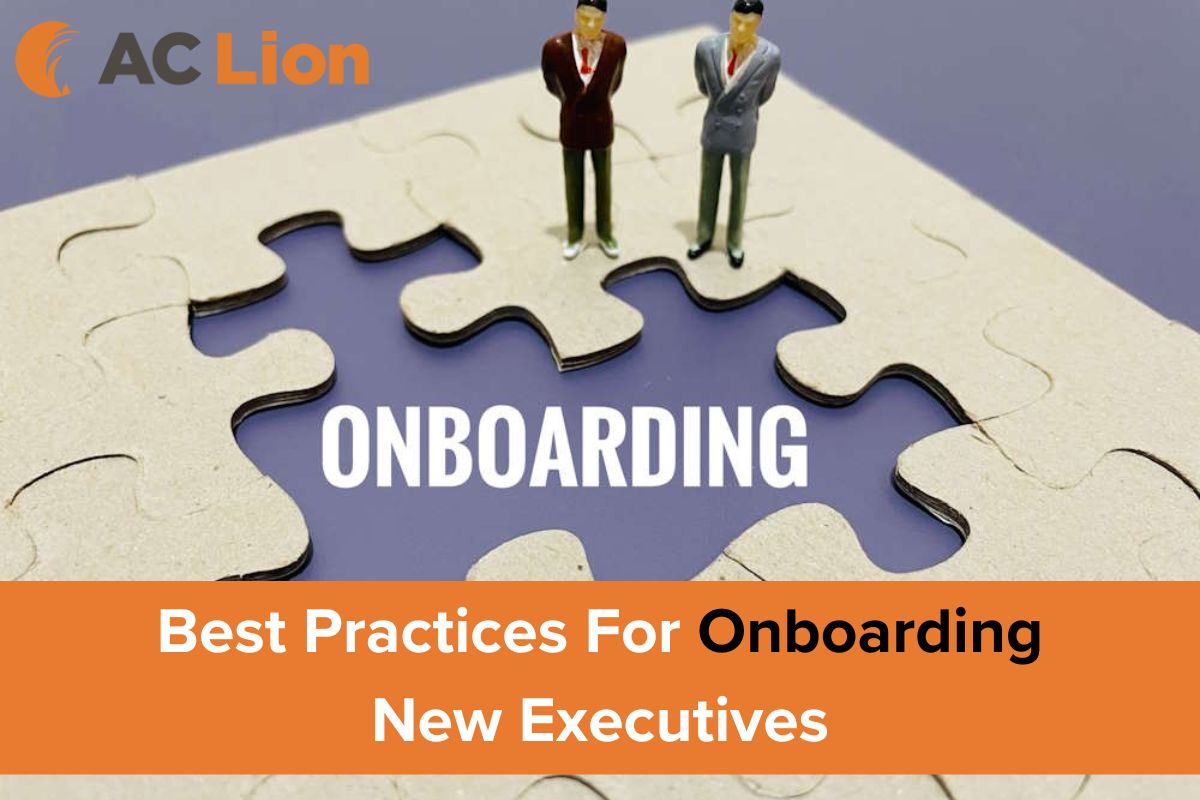Best Practices For Onboarding New Executives


The executive onboarding process is essential to ensuring a smooth transition for new executives. An effective onboarding plan for executives is critical to enacting positive organizational change, improving executive performance, and unlocking organizational success.
Following onboarding best practices can help you elevate your business and enhance your employee’s overall performance, especially if you’re implementing tailored onboarding strategies for executives compared to general employee onboarding. But what onboarding best practices are crucial to your success? Read more to find out.
Pre-Onboarding Strategies
A successful executive onboarding process doesn’t start with the executive’s first day in their new position. Onboarding executives begins before the first day on the job, involving key pre-onboarding strategies to guarantee a seamless journey ahead.
Establishing communication with the executive before their first day is crucial, including extending a welcome message and providing informational packets about the company and the executive’s role.
Beyond initially welcoming the executive to your team, your new executive will want a clear idea of what’s expected from them during their initial weeks on the job. Preparing a detailed plan outlining the executive’s first few weeks – including steps like meetings and introductions – can help the executive feel more comfortable about the onboarding process.
Promoting new executive adaptation requires direct involvement from your HR department and direct supervisors to facilitate the employee’s onboarding experience – so always stay involved during the executive onboarding process.
First Day Essentials
Leadership onboarding strategies are most effective when you emphasize the employee’s first day of work – a time that’s too often overwhelming and stress-inducing, leading to poor performance. As you navigate onboarding executives, it’s essential to promote a structured first day and prepare the executive for what he or she can expect during their first day on the job.
Remember, you don’t want to overwhelm the executive with too much information before they’re comfortable in their position. Consider beginning the onboarding senior executives process with a welcome meeting, including all key team members, and a tour of your office for in-office workers.
You’ll also want to ensure the executive is as prepared as possible to start helping your organization, so provide thorough information in a welcome packet including essential company details. For instance, organizational charts, strategic plans for the future, and details about your current projects can go a long way in making a new executive feel more comfortable and confident.
Building a Strong Foundation
If you don’t build a foundation for success, you can’t expect the executive onboarding process to go smoothly. Equip new executives with everything they need to start their journey positively, such as assigning the new executive a mentor or implementing a buddy system for additional guidance and support.
Ensuring a seamless transition requires leadership integration tools, which the executive will need to take leadership in their new position. Guarantee the new executive has access to crucial tools, accounts, and resources they’ll need to fulfill their leadership responsibilities.
It would help if you also considered setting up introductory meetings with your organization’s key stakeholders and department heads to build a foundation where the executive feels they can succeed.
Setting Clear Goals and Expectations
All leadership onboarding strategies should outline clear goals and expectations that the new executive can adhere to to ensure success during their first few months in this position. Executives want to feel like valued members of your business – so consult with new executives to discuss their objectives in this position and determine how they can align with your company’s strategic goals.
Maintaining clear goals and expectations requires regular meetings to review the executive’s progress, understand their shifting goals, and make adjustments as necessary. Always take action to stay informed and ensure your executive’s desires in their position align with your company’s expectations for their work.
Cultural Integration
Your company’s culture is a core part of its existence – and any holistic onboarding approach requires you to immerse new executives into your organization’s culture. Keep the executives involved by encouraging them to participate in company events and hosting informal meet-and-greets to help them embrace your company’s values and feel like important team members.
You must understand how your company’s values translate into its daily operations; it’s time to make changes if your values don’t align with your work. As you analyze your organization, take time to facilitate discussions and meetings with executives about your company’s history, challenges, successes, and workplace dynamics – it’ll ensure the executive is more comfortable with their job.
Ongoing Support and Feedback
For any executive to succeed, they need ongoing support and information about how they’re performing in their role. Beyond the initial onboarding period, ensure you provide continuous support to your executives through practices like regular one-on-one meetings where you can provide and receive onboarding feedback and development suggestions and discuss challenges the executive is facing.
As the executive adapts to their new role, discuss the role of performance reviews in their ongoing development and adjustment to the role. Ensuring the executive knows what to expect regarding the support offered by your company is essential to a successful executive onboarding process.
Measuring Onboarding Success
Knowing the effectiveness of your onboarding plan for executives is crucial to ensuring the process remains smooth and successful. Collecting feedback and development strategies through surveys and executive onboarding metrics is critical to guarantee ongoing success.
Consider conducting interviews or surveys with new executives and their teams to gather insights on the onboarding experience and adjust based on feedback. You can also use technology integrations to conduct online surveys for executives to remain anonymous.
Always remain flexible and adaptable when you receive feedback from executives – there’s always room for improvement in your onboarding practices.
What are the Key Elements of an Effective Executive Onboarding Program?
While numerous components go into a successful onboarding program, there are a few elements to emphasize during the onboarding process. Ensure you have a structured and comprehensive onboarding plan to which you and new executives can adhere.
Some of the main elements to consider when creating an onboarding plan include:
- Executive orientation
- Training programs
- Mentorship
- Goal setting
- Cultural integration
How Long Should the Onboarding Process for a New Executive Last?
Numerous factors influence the length of an executive onboarding process, such as whether you’re onboarding senior executives. Executives will feel a need to start contributing instantly to your business, so it’s important to strike a balance between comprehensive orientations and the executive’s desire to contribute.
Generally speaking, the onboarding process for training new executives lasts around 90 days, covering the first few months of the employee’s journey with your company.
What are Common Mistakes to Avoid in Executive Onboarding?
Mistakes are part of the learning process – but avoiding onboarding errors as much as possible is critical for a seamless onboarding experience. Promoting personalized experiences and encouraging regular feedback from executives on their onboarding experience helps you make necessary changes in the future.
Some mistakes you might encounter during onboarding include:
- Insufficient support from team leaders
- Information overload that occurs when information isn’t shared progressively
- A lack of clear objectives for the employee to strive for
How to Tailor the Onboarding Process for Different Executive Roles?
Not all executives serve the same purpose for your organization – so knowing how to tailor the onboarding process for different roles is critical to organizational success. Create role-specific onboarding programs that account for different executive positions’ unique challenges and responsibilities.
Some strategies to consider to tailor the onboarding experience include:
- Job shadowing, where new employees can shadow employees in similar roles for insights into day-to-day responsibilities
- Customized training plans based on the unique responsibilities of each executive role
- Role-specific documentation provided to new executives before their first day, such as job manuals and guides
- Orientation sessions tailored to each role rather than generalized for all executives
- Role-specific modules that detail information, tools, and resources relevant to different positions
- Customized welcome kits for different executive roles
- Workshops tailored to different roles that simulate scenarios executives in specific roles might encounter
What are Effective Strategies for the Remote Onboarding of Executives?
Remote onboarding is critical for employees who don’t work on-site – and not tailoring onboarding experiences to these employees can make it challenging for them to adapt to your company’s culture.
When onboarding remote executives, take advantage of virtual onboarding tools. Conduct online training sessions and promote digital networking opportunities to ensure all employees feel valued in your organization.
How Can Technology Be Utilized in Executive Onboarding?
Beyond using technology for remote onboarding, there are several ways that technology can be utilized during the executive onboarding process.
Tools like onboarding software, virtual reality experiences, and AI-driven platforms are all effective tools that streamline the onboarding experience and ensure success.
How Can Onboarding Be Customized for International Executives?
International executives face unique challenges during onboarding, including cultural differences and relocation issues. Ensuring onboarding is tailored to international executives is critical for organizational success.
Implement onboarding strategies tailored to helping international executives, such as offering language support to make communication easier and cultural training programs to help these employees adjust to an unfamiliar culture.
Learn More With ACLion
A successful onboarding program for new executives has long-term benefits, from promoting organizational growth to driving a culture of continuous improvement. Ensuring your onboarding process is constantly evolving to meet the changing needs of executives within your organization is critical to long-term success.
Several key processes for a successful onboarding experience include pre-onboarding strategies, culture integration, and ongoing support and feedback. You can stay informed about the best onboarding and recruitment practices by exploring information from ACLion today for more insights!
